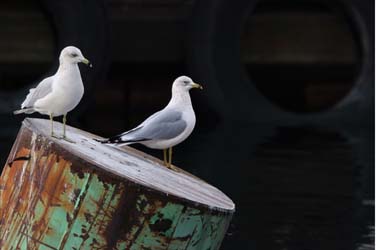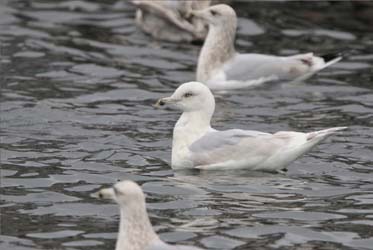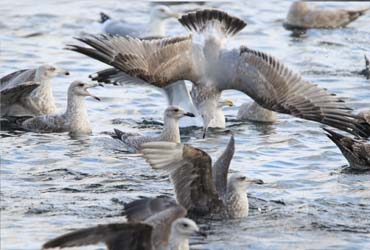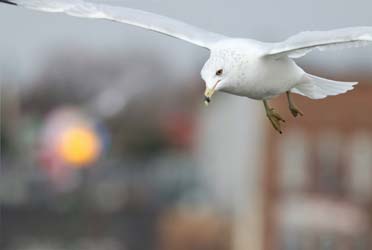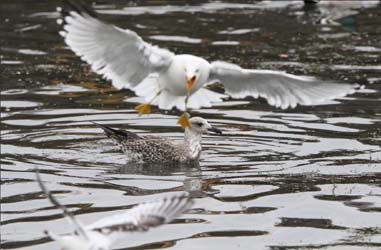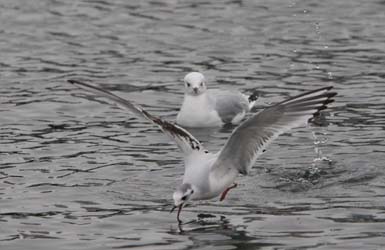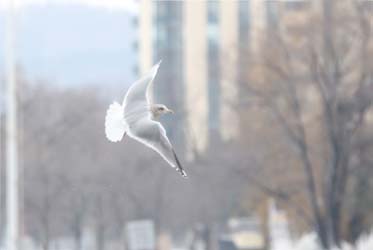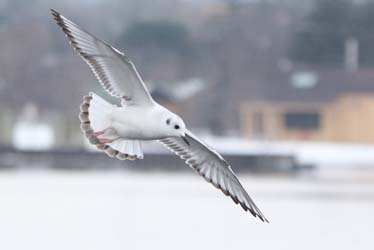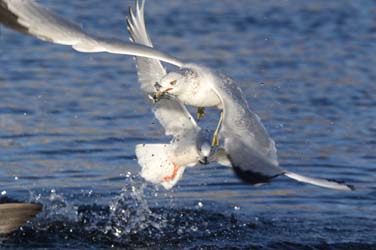
Since November 2006 until October 2017, there has been a monthly FIND – about 120.
Margo Holt and I Nancy Ironside initiated this endeavour. When Margo left us,
Nancy has continued to coordinate and edit.
Many people have helped, some people doing whole pages, and others
contributing their expertise – some amateurs, some experienced amateurs,
and some professionals in their fields. Many have helped with photographs.
There is recognition for text and photos, and thank you all.
Everyone who has been approached for help has been very cooperative.
There is a wealth of information in these pages.
There is a table of contents on the right upper corner.
2015 ~ 2014 ~ 2013 ~ 2012 ~ 2011 ~ 2010 ~ 2009 ~ 2008 ~ 2007 ~ 2006
Table of Contents
October 2017 Rock Tripe wall -Umbilicaria sp.
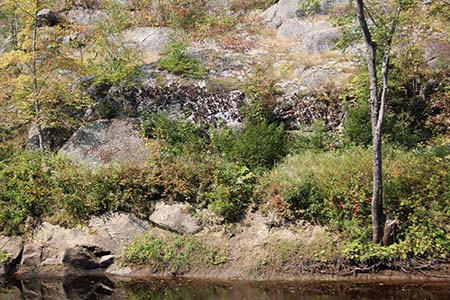
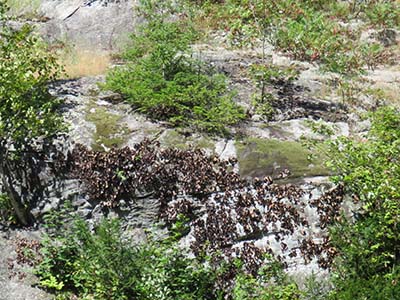
Lichen walls were found on rock faces on both sides of the Black River.
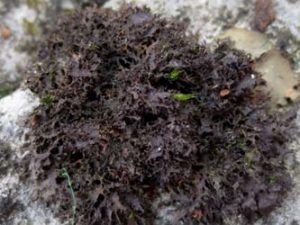
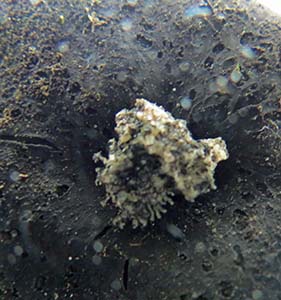
The lichen looks and feels like leather It is attached to the rock face by an ” umbilicus” that is half the size of a dime When we were walking along the road at the Black River Wildlands, we saw several walls of Lichen –Umbilicaria sp., on both sides of the Black River. Rock tripe is fairly common on granite rock faces, on the shield, but it always impresses, especially in a wet period, when it expands and appears to be made up of large leaves. It feels like leather. When dry it shrivels up, becomes brittle and can easily be broken. When fresh this “ leaf” would be 4 or 5 inches across, but it is strongly attached to the rock by a short, thick “ stem” or umbilicus, which is only about half the size of a dime. What gives this attachment such power to hold the large thalus in place, for years regardless of the weather?
For years we have said that a lichen is a union of a fungus and an alga,
and have even debated whether that made it an ecosystem or a species.
Using modern DNA/RNA-based and microscopic techniques we now know that lichens are much more complicated structures than we had any idea, and they definitely are an ecosystem. (We have also learned that we humans are ecosystems, and we could not live without the bacteria
that populate our gut, our skin, and almost every part of us.) Many unrelated fungi form lichens, but 98% are cup fungi or ascomycetes.
(There may also be yeast, which is a fungus.) About 100 species of algae associate with fungi, but mostly they are green algae or blue-green algae
(cyanobacteria -not a bacteria). Typically the fungus (mycobiont) associates with a particular alga (photobiont); they may associate with more than one, or may change to others according to their environmental situation.
The fungus benefits from the algae or cyanobacteria because they produce food by photosynthesis
But now we know that there are microbial communities associated with lichens and they play a role, such as forming biofilm-like structures on parts of the thallus, or they may have lytic capabilities.
Some bacteria can eat rock. So is the thallus attached by filaments of rhizinomorphs that are strong enough to hold’ even in storms or do the newly identified bacteria have a role? We will see.
Photos by Donald Macdonald, Sheilagh Rose and Heather Ewing
September 2017 Dogwood Sawfly, Macremphytus tarsatus,
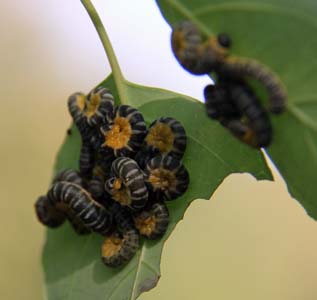

On September 17 a group was visiting the Black River Reserve (a property being bought by the Couchiching Conservancy), when we saw a “nest” of caterpillars. Fortunately, Gayle Carlisle (our guide) had received a photo of similar caterpillars from a friend, in the previous week, and she had “googled”: black and white ringed caterpillar. Up came a website for gardening questions, and so she was able to identify the group as Dogwood Sawflies.
These caterpillars do not turn into a butterfly or a moth, but into a sawfly. But a Sawfly is not a fly, but a wasp. And it is wasp that does not sting. The caterpillars are species specific so these are called Dogwood sawflies. Our caterpillars were found on Dogwood, but most dogwoods have opposite leaves. Our caterpillars were found on Alternate leaved (or Pagoda) Dogwood. Nevertheless the leaves have the characteristic arrangement of veins of a dogwood. Nothing is as expected.
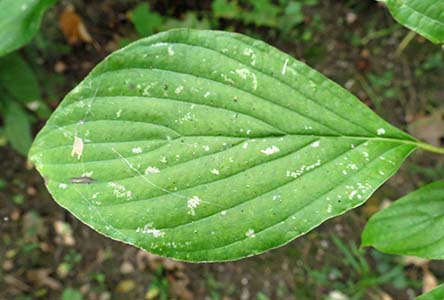
The larvae, which feed on the leaves through the summer, are probably in the last instar. You can tell the larvae are sawflies because they have at least 5 sets of prolegs – if you can see them from the side. They can cause quite noticeable defoliation of dogwood shrubs but don’t kill the plants. They will now drop to the ground to overwinter in cocoons , made of rotten wood.
When they emerge in the spring they look like flies, but actually have four wings, (Hymenoptera), not the single pair that is characteristic of flies -order Diptera. The cluster was spectacular, but the identification might have been very frustrating.
The Black River Reserve is on the road that continues east along the river, after Cooper’s Falls, and is surrounded by the Queen Elizabeth II Wildlands.
Photos by Heather Ewing, Cathy Bernatavicius and Sheilagh Rose
The identification has been confirmed by Nathan Schiff, Ph.D.
Research Entomologist, Forest Service SRS, and comments added.
August 2017 Queen Anne’s Lace and Chicory Two alien Invasives we love
Photo gallery below – use arrow on the right to see more photos
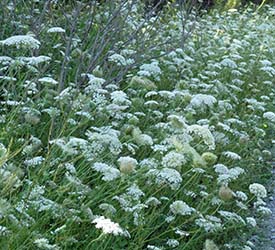
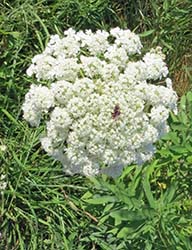
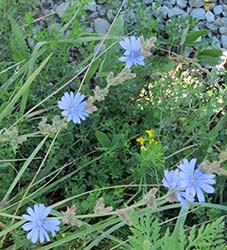
Photos by Heather Ewing
In this summer of rain, the flowers are at their best. Queen Anne’s lace borders the country roads like an honour guard, a background for the sky blue Chicory flowers.
Queen Anne’s Lace (Dauca carota ) was named for the wife of James 1 (of Bible fame), who enjoyed tatting lace. When she picked her finger the blood spotted the lace, and so the sterile reddish purple flower in the centre of the bloom.
It is an alien biennial plant. The first year the shrubby rosette of leaves establishes itself –maybe unnoticed. (This is similar to the life style of Garlic Mustard.). The second year the lacy umbel of thousands of tiny, white flowers appears. While the centre floret is sterile the other ones, maybe 40,000 per plant, have fertile seeds –very invasive. (It is a host plant for the Black Swallowtail caterpillar.) It is native to Europe and some of the middle east and was brought here by early settlers –similar to Chicory.
Chicory ( Cichorium intybus), also an alien, is a perennial plant with beautiful bright sky blue flowers, which open only on a sunny day, and reproduce only by seed. All the Goldenrods ( Solidagos) are native, but invasive, as is Ragweed ( Ambrosia). All of these add to the beauty of our roadsides.
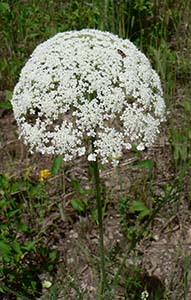
Photos from the collection of Margo Holt
July 2017
CARRION /BURYING BEETLES CARRYING MITES
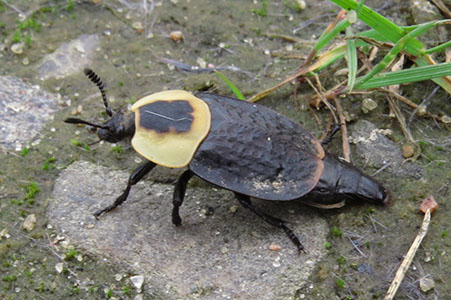
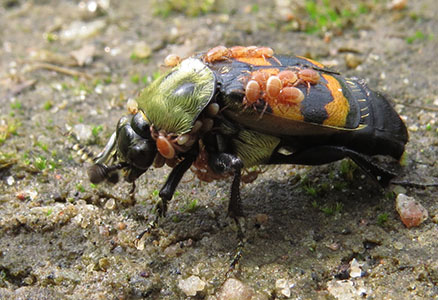
On the first of July weekend, 2017, David Goodyear found a dead mole at the Bracebridge Sewage Lagoons. It was being slowly eaten by several carrion beetles. He reported on the Muskoka Nature Board that most of them appeared to be American Carrion Beetles. The adult beetle will lay eggs near/on the dead animal and the larva will hatch out to a food source.
When they moved the mole a burying/sexton beetle (maybe Nicrophorus tomentosus?) came out from underneath: It was carrying several mites on its body. The mites apparently hitch a ride with the beetles from food source to food source. The mites eat the maggots and fly eggs that are also on the dead animal, thus reducing potential competitors of the burying beetle’s larva. This is a symbiotic relationship known as phoresy, in which one species is carried about by another.
David Goodyear has allowed us to use his photos and information for our July Find. David is the President of the Muskoka Field Naturalists. Thank you, David; and thank the beetles for helping to keep our world free of dead bodies.
June 2017
REGENERATION OF A BURR OAK SAVANNA BY FIRE
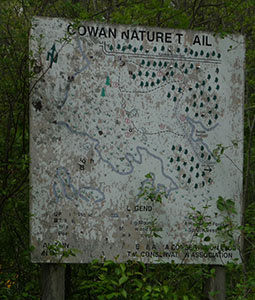
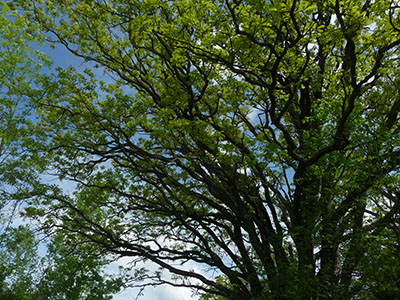
Much of the management of the MNR owned Matchedash Bay area, was done to encourage wild life, especially ducks. However, it was recognized that the area near the Cowan Trail, just off Kinnear Road, had been a burr oak savanna. It would need fire to return this area to a beautiful canopied parkland, now overgrown with brushwood. There were no young oaks. The huge mature oaks were showing dead branches.
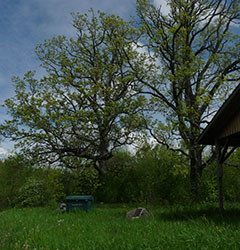
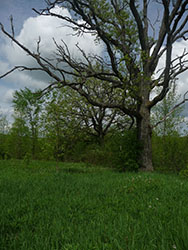
There was a long history of use of this area by the native peoples, who were well known to use fire regularly to maintain open grassland, both for growing crops, and for feeding grounds for deer. Moreover, some cones and acorns require heat to germinate, so fire increases the survival of seedlings.
About 15 years ago the MNR, led by Gary Allen, arranged a prescribed burn.
Following that a group of volunteers planted native savannah plants and grasses. We questioned the success of the burn when the trail was covered with Scotch Thistles the following year. Gary Allen moved on, and there were no more burns and no documented follow up.
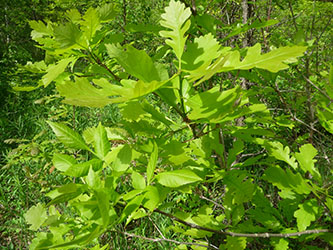
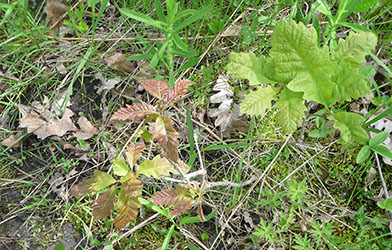
This year we recognized what I consider to be a success story. There are so many young, well-established burr oaks – too many to count, all along the trail, from the parking lot at Kinnear Road past the picnic shelter.
Some are 6 to 8 feet tall. They are growing among the poplars and other shrubs. As the oaks thrive the short-lived trees will be too shaded, and the oaks will be the dominant tree. We wonder how much of the open savanna will be re-established. On your next visit to Matchedash Bay Cowan Trail to find warblers and gnatcatchers, check out the oaks.
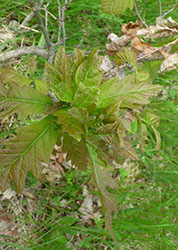
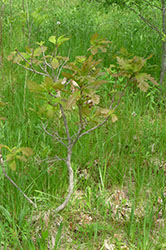
Fire is being often used as a management tool, especially in the north. However there are records, nearer to us, of the repeated burns in High Park used to maintain the Black Oak savanna. (Black Oak is a similar but more southern tree.) 12 areas of the Park have been burned from 1997 to 2007 –about 30 burns. They consider their success was largely due to dedicated volunteers, who planted desired species of plants and grasses. Interestingly, Dog Strangling vine emerged before other vegetation, and Glossy Buckthorn was resprouting within 2 years.
May 2017
Moose family in sedge wren meadow, Carden Alvar
( Scientific name: Alces alces)
On May 19 Arni Stinnissen was able to photograph this moose family –a cow and 2 calves. A group from the Muskoka Field Naturalists saw them as well. (They were also reported on May 20). Moose are not a rare sight in Carden, but always cause excitement.
More than any other member of the deer family, moose spend time in the water, especially because they can dive 5-6 meters for plants at the bottom of the lake They have the biggest noses of any member of the deer family. They have a complex nostril closing system that allows moose to forage underwater.
Facts:
1. average weight of female: 350 kg. (770 lbs) Male moose can grow to 1200 lbs , and stand 5-6.5 feet tall – taller than most people.
2. In spring, summer and fall they eat 50 to over 70 pounds of food.
3. They are herbivores.
4. Female moose have 1-2 calves a year, in May , and stay with the mother until the next calves are born –1 year.
5. The population is either increasing, decreasing, or stable.
Unknown Fact:
How do these large voracious animals affect the nesting birds, such as sedge and marsh wrens in the marsh?
Photo gallery below – use the right arrow to see more photos
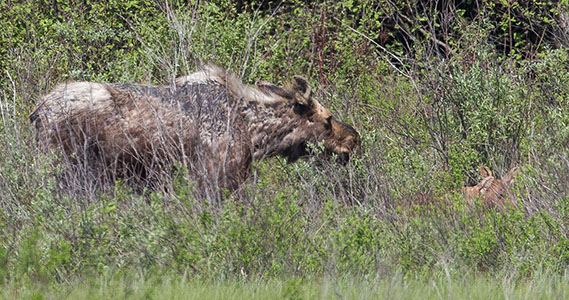
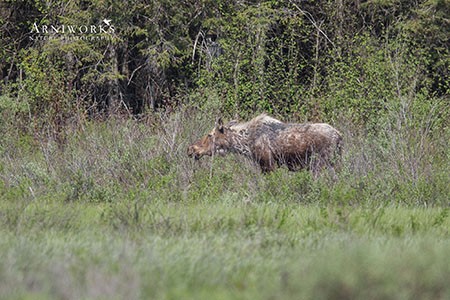

April 2017: Brook Stickleback Trout (Culea inconstans)
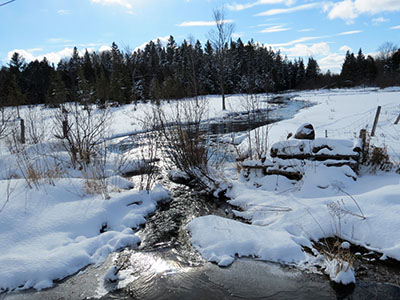
This is a photo of McGee Creek on Shrike Road in the Carden Plain, during the winter ( from Heather Ewing). The Brook Stickleback Trout are probably swimming here, in running water in the winter. Vicki and Bill Sherwood sample the water from this Creek, as part of the Citizen Science project of Couchiching Conservancy.
Water teams are trained to monitor water quality throughout the Couchiching Region. They test for eight different water quality parameters including phosphorous, nitrogen, temperature, depth, and Ph. Teams of two are assigned a site and collect water samples once or twice per month in the spring, summer, and fall. Benthic kick-tests are taken annually at each site to monitor for benthic macroinvertebrates (bottom dwelling aquatic organisms visible to the naked eye with no vertebrae).
Diary of Bill Sherwood:
April 2
Dorthea Hangaard has been after us to use dip nets to see what is living below the surface of our streams. A couple of weeks ago I pulled up snails per 30cm drag along the bottom. And yesterday was similar. However, the current was very strong/I am very weak (minded?). So in an act of scientific curiosity I extended the net into the main stream of current (thought) and pulled in a surprise. Now it may seem strange, but I had seen such a fish before in our pond in Germany – a stickleback. They are incredibly interesting fish, a delight to observe, very entertaining – trout leave them alone!
But what kind? 5 spines so I Googled 5-spine Stickleback and got three! I got help this morning and I have Brook Stickleback. How big? Here comes Home Hardware to the rescue: He doesn’t look to happy here but he swam away alright seconds later. Now if he defends, like the previous ones I got to know, there won’t be too many males around, maybe none for several meters of stream, but there might be several females. I did not catch any more. Will try again soon.
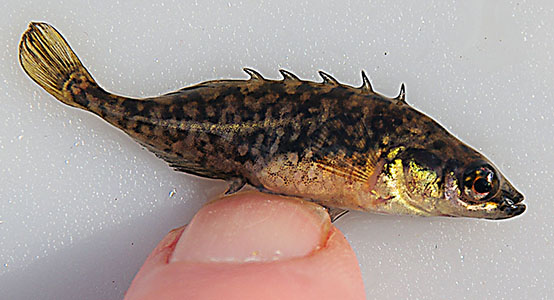
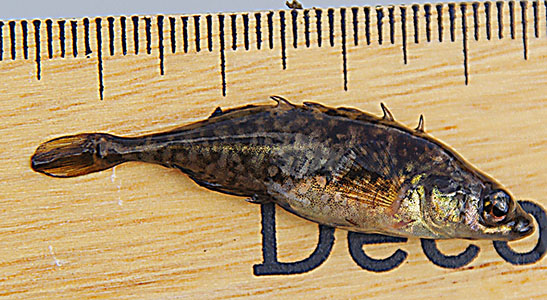 The Brook Stickleback Trout are native to Ontario and spawn in rivers, usually in the spring or summer. They are tolerant of low dissolved oxygen, acidity and alkalinity; but intolerant of turbidity (running water is not turbid). Often they are the only species occurring in marginal habitats.
The Brook Stickleback Trout are native to Ontario and spawn in rivers, usually in the spring or summer. They are tolerant of low dissolved oxygen, acidity and alkalinity; but intolerant of turbidity (running water is not turbid). Often they are the only species occurring in marginal habitats.
The overall colour is olive green, with indistinct mottling, but the spawning males are black , and the females show dark and light patches. The eggs are laid in June or July, in a nest built by the male , who entices females in to spawn. Then the male stays with the fertilized eggs, fanning them with oxygenated water, until they hatch and can fend for themselves.
March 2017: A Busy Country Bird Feeder
At regular intervals from November to April, thousands of Feeder Watchers count the kinds and numbers of birds at their feeders, then they submit their observations to Project FeederWatch. This information helps scientists study winter bird populations. This is one of the best Citizen Science projects –it is fun and produces meaningful data. Project FeederWatch is a joint program of Bird Studies Canada and the Cornell Lab of Ornithology.
In Canada, you must be a member of Bird Studies Canada (BSC) to participate. There are birds who are around, but do not come to feeders, such as Brown Creepers, so data on them may not be collected. If there is an owl at the feeder, it is probably there to collect mice that come to the spilled food on the ground at night.
Some of the most interesting feeders are in the country, often a mile or two from the next feeder. Sue Deadman, in mid Severn Township has one of the busiest. She as been feeding for 7 years and as been collecting data for 3 years. This year for the first time, evening grosbeaks visited the feeders. Starting with 1 and gradually building over a 4 week period to 24 when they left. Noticeably absent were hawks.
The maximum number of each species seen at one time from Nov. 2016 to Mar. 2017 are as follows-
Purple finch – 10
Junco – 3
Tree sparrow – 4
Downy woodpecker – 4
Hairy woodpecker -5
Pileated woodpecker – 1
White-breasted nuthatch – 6
Chickadees – 15
American goldfinch – 60
Mourning doves -3
Red winged blackbirds – 24
Grackles – 24
American crows – 6
European starlings – 6
Blue jays – 7
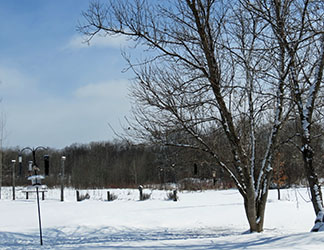
Within 75’ is a dense mixed forest
Photo Gallery below – use right arrow to see more photos

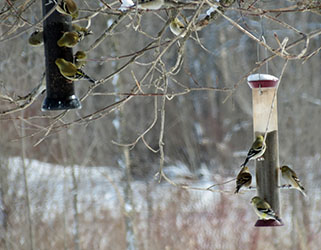
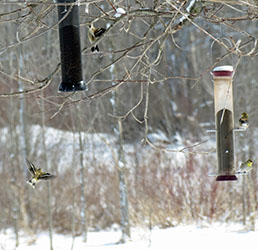


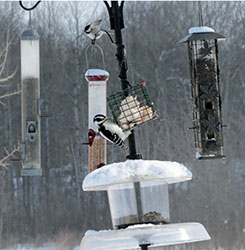
Seed consumed – 90 lbs. of nyger seed in 2 feeders
-180 lbs. of black oil sunflower seed in 2 silo type feeders and 1 hopper
-20 lbs. of mixed seed in 1 silo feeder
Suet – 40 lbs. at 3 feeding stations
21 wild turkeys, 8 red squirrels and 1 rabbit keep the ground waste cleaned up.
On March 27 she wrote: There are 200+ mixed grackles and red wings here now. Make that 300 + They are everywhere. Watched the turkeys courting and breeding on the lawn yesterday. Quite a display. Lucky Sue.
Her Comment: I have no doubt these birds would survive the winter without me, but they provide relaxing entertainment on a cold winter’s day.
Photos by Heather Ewing
February 2017 :
Picea Marianna – Black (Bog) Spruce Forest
The iconic silhouette of the Black Spruce (also called Swamp or Bog Spruce) is that of a straight cylinder with an oddly shaped cone on top – absolutely identifiable. It grows in peat deposits in poorly drained bogs, with poor nutrients and low pH, often surrounded by Tamarack. In Simcoe County these conditions are found in the Bass Lake Swamp, which has many uniquely northern flora. Otherwise these types of bogs are mainly confined to the Precambrian Shield, in the old Matchedash area of Orillia Township.
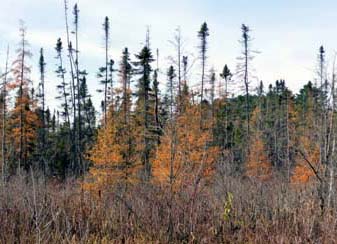
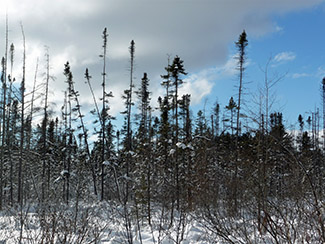
These photos, taken from the Big Chute Road, show one of the most easily accessible Black Spruce swamps (easily visible that is). They highlight the silhouette. The photo on the left also shows the Tamaracks, which have not yet lost their needles, in November. Black Spruce have straight trunks, and short branches so they can grow closely together to support each other in wind or snow – absolutely vital, since the root system is so shallow.
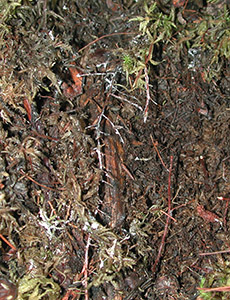
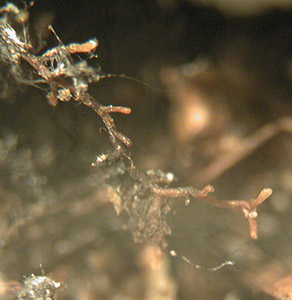
These photos show the roots, where the soil has been brushed back, encased in the sheath, which is the ectomycorrhizal fungus. (photographed in another small spruce bog, also in Matchedash.)
As Peter Wohlleben says in the book The Hidden Life of Trees, half of the biomass of a forest is in the hidden understory. It is in this root and fungal network that the trees communicate their needs to one another, presumably by electrical impulses. Peat, which is partially decayed plant matter, especially Sphagnum, is very poor in minerals and nutrients, and poorly oxygenated, so that many trees cannot survive.
However, in undisturbed forests, there is a fungal network of mycelium.
Peter estimates that 1 teaspoon of soil contains many miles of mycelium.
These form a symbiotic relationship with the tree that provides carbon to the fungus, in exchange for nutrients, such as phosphorus or nitrogen.
The mycelium may congregate to form mycorrhriza, which may form an external encasing sheath around the whole root system
January 2017 :
A homeless wandering SPOTTED SALAMANDER
(AMBYSTOMA MACULATUM)
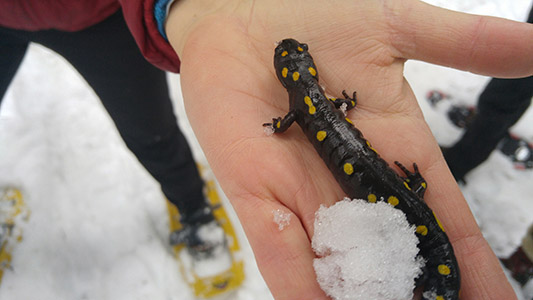
It was a mild Friday afternoon in early January, when the staff of The Couchiching Conservancy were snowshoeing at the newly acquired 107 acre Adams Nature Reserve, North East of Washago. To our surprise, and confusion, we came across a Spotted Salamander (Ambystoma maculatum),
about 7 inches long, crawling along our snowshoe trails in the snow. It was moving very slowly and ‘froze’ in its place once we all got closer. It was suggested by Ginny Moore that the Salamander was moving because the recent thaw had flooded its home. This was suggested again by Peter Mills on the Simcoe Nature Board, where David Hawke posted the sighting.
Spotted Salamanders mostly hibernate in relatively deep burrows made by deer mice, and they choose ones in the autumn that are oriented in places that will drain well. A burrow that floods and doesn’t drain will end up being lethal!
We all took a good look at the Salamander and Dorthea Hangaard moved it to a nearby tree stump that could hopefully provide habitat. In their normal life cycle, Spotted salamanders breed in early spring, often while there is still ice on ponds. Many salamanders are killed on our roads every spring during their migration from their winter hibernating site to breeding ponds.
Photo and report (condensed) from Tanya Clark
December 2016 : 2 NORTHERN GOSHAWKS ON THE CHRISTMAS BIRD COUNT
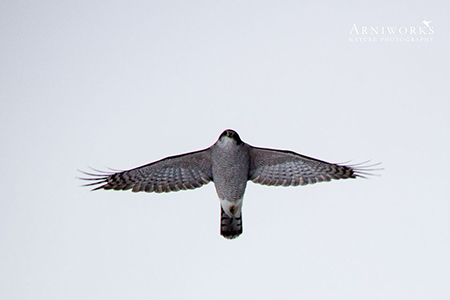

Northern Goshawks have been ‘occasional’ on Xmas bird counts.
From 1981 (when the records were first kept) there have been 8 sightings of a single bird–that is in 35 years. There have been highs of 4 in 2009 and in 1998. This year there were 2 birds sighted, in different territories, and one was photographed. There are 2 feeders in Oro-Medonte, on the 9th line N, across the road from each other. The bird-counting group of Arni and Dianne Stinnissen , Leanore Wiancko and Ray Kiff, were counting the birds at the north feeder when this Goshawk flew in. The feeder birds scattered in a panic. It stayed close to the feeders for a short time and then moved to taller trees about 100’ north. When it took off it went directly over Arni’s head towards the feeders that were on the other side of the road. This resulted in Arni getting the perfect shot –shape, (the perfect Accipiter silhouette), and tail and wing banding. In our area Northern Goshawks rarely occur south of the 45th parallel during the breeding season.
Many adults winter as far north as the species breeds. Most of us only see the birds when they are nesting, so that they fly through the woods, calling and aggressively defending their nest, or they might flash through forests chasing bird and mammal prey. We rarely see the perfect shape and banding, as in these photos.
Photos by Arni Stinnissen
November 2016 CATTLE EGRETS VISIT ORILLIA AREA
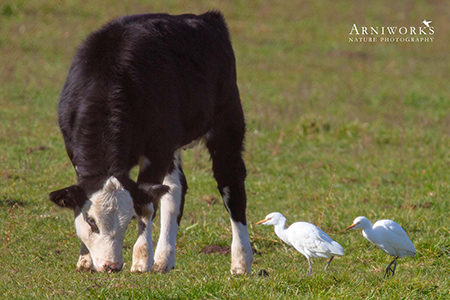
Photo from Arni Stinnissen
Photo gallery below – use right arrow to see more photos
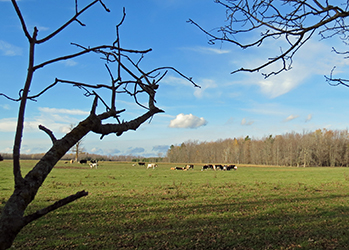
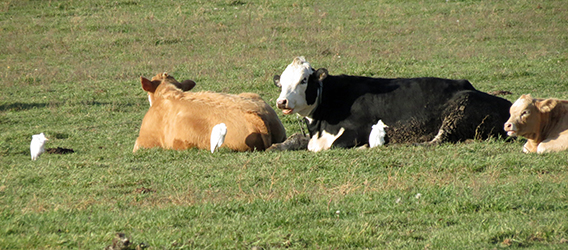
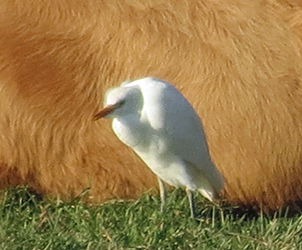
There are 3 birds in this photo. This shows the bird’s characteristic hump. Photos from Heather Ewing
We had visitors this month. On Friday Nov 4 there was a sighting, posted on Ont Birds, of 4 Cattle Egrets (which later increased to 5) at 1280 Cambrian Road, near Burnside line, north of Orillia. They stayed near the cattle, but sometimes foraged in a creek that flowed through the field. At about the same time, Wendy Hutchings reported 2 Cattle Egrets near the Oro-Medonte Rail Trail at the 15th line, with cattle (and a donkey). Wendy had been alerted by a fellow hiker. All 7 birds probably left during the stormy weather on November 11th.
Cattle Egrets are small white egrets from Africa, who expanded into Surinam (and Brazil) in 1877. They reached Florida by the 1940’s and were first recorded in Ontario in 1956. They gradually became a more common visitor, peaking in the 1970s. Since then there has been some retrenchment of the species. This year there has been a minor influx, with records, since late October, in several places in Southern Ontario. A lone bird has been reported regularly at Sir Sam Smith Park , Etobicoke, since Nov 6 and was still there Nov 19. Most birds associate with cattle and follow them, feeding on the insects or detritus stirred up by their hoofs. On Pelee Island a lone Cattle Egret was reported, flying behind a combine while the farmer harvested Soya beans. When tired it rested at the tractor and wagons.
For those who travel south, this is a common bird, but for many it was a “life” bird. For many of us, being out in nature and watching birds restores our soul. But in 2017, you are more likely to find a rarity, or a life bird, by watching your smart phone screen.
October 2016 RUSTY BLACKBIRDS ON FALL MIGRATION
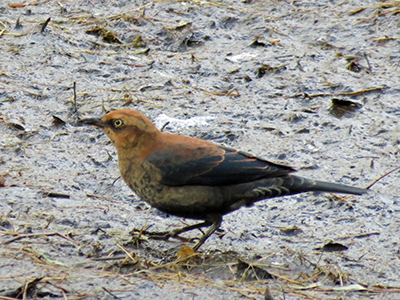
Female non breeding Rusty Blackbird
During the fall walk to Fawcett/Agnew Conservancy properties just west of Washago, on Sunday , October 2nd 2016, a small flock ( probably 3) of Rusty Blackbirds was spotted by Pat Woodford, identified by Ron Reid, and photographed by Heather Ewing. Unfortunately the others in the group did not see them. In 1967, as a centennial project, the birders in Simcoe County compiled and published The Birds of Simcoe County, compiled by O.E. Devitt, from observations of local birders. They called the Rusty Blackbird “ a fairly common spring, and very common fall transient”. D.S. Miller reported 200 birds at Oro Station on Sept 25, 1941. At the Holland River, W.W. Smith and O.E Devitt witnessed a great movement of Rusty Blackbirds, estimated between 2,000 and 3,000 birds on October 15, 1944.
But things have changed.
3 birds spotted and photographed near the Severn River on an ONC outing may be among the few small groups of Rusty Blackbirds seen this fall. Birders are lucky to catch a glimpse of these often-overlooked birds.
What has happened in the last 70 years?
A recent study published by a group of the top birding scientists in Ontario in the Ontario Birds (a publication of the Ontario Field Ornithologists)
listed the 25 species showing the largest increases and the largest decreases in Ontario in the period 1983-2013, largely based on Breeding Bird studies.
The Rusty Blackbird was #7 among the largest decreases with an annual % change of 5.9%. (You may be interested to know that the House Sparrow was #12, with an annual decrease of 4.3 %, and the Bobolink was #20,
with an annual decrease of 3.5%.).
Rusty Blackbirds have experienced one of the steepest population declines of any once-common North American bird. The population has plunged an estimated 85-99 percent over the past forty years and scientists are completely puzzled as to what is the cause, but is “thought to be due to habitat loss on the winter range (e.g. conversion of forests
on the Mississippi floodplain to agricultural and urban habitats) and blackbird control programs that have been underway in the southeastern United States since the 1970s. Other possible causes of the decline include wetland acidification, mercury contamination, disease, and habitat
loss and degradation on the breeding grounds through conversion to agriculture, peat production, reservoir formation, and logging, as well as drying and changing water chemistry of boreal wetlands due to climate change.” In other words, nobody knows why.
This Blackbird breeds in the north, across Canada. In Ontario it breeds mainly in the Hudson Bay Lowlands. It is almost always found near water, during migration, and on the summer and wintering grounds. Studying its nesting habits is difficult, -floundering in bogs and enduring mosquitoes and other insects.
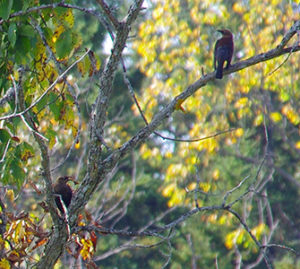 Bill and Vicki Sherwood have been monitoring water quality in Magee Creek, Shrike Road this month, and photographed this small flock in a tree near the water.
Bill and Vicki Sherwood have been monitoring water quality in Magee Creek, Shrike Road this month, and photographed this small flock in a tree near the water.
September 2016 FUNGI REACT TO STRESS
August 2016 has set a new record, as being the hottest month of August that anyone has lived through, since we began keeping temperature records,
137 years ago. There was an associated drought. Trees and plants were stressed and we wonder whether some will survive, – next summer will tell.
Butterfly numbers were decreased, and the ones we did see were flitting from one shrivelled floret to another, searching for nectar. But how about the mushrooms?
The mushroom visible above ground is actually the fruiting body.
The fungus itself is mass of filamentous growths or ‘hyphae’ beneath the soil, or on a substrate e.g. dead wood, on which the fungus is growing. The dead wood and the underground body would also dry out and be deprived of water. But this September has been a great year for mushrooms, at least at Grant’s Woods, the Couchiching Conservancy headquarters. At the Mycological Society of Toronto’s annual fall foray, around Limberlost Road between Huntsville and Dorset there were great numbers of fleshy fungi –some were at the upper size limit?
I hypothesize that the fungus, feeling the drought conditions, feeling that their substrate may be at risk, reacted by sending forth large mushrooms with many spores, as soon as the September rains came. They wanted to establish a new venue to continue their species, to preserve their genetic legacy – their reaction to stress.
These are a sampling of photos taken by Heather Ewing on September 25th at Grant’s Woods. The names may be outdated, but they are the names most likely to be found in books that most people use. The identification has not been verified microscopically.
Photo gallery below – use right arrow to see more photos
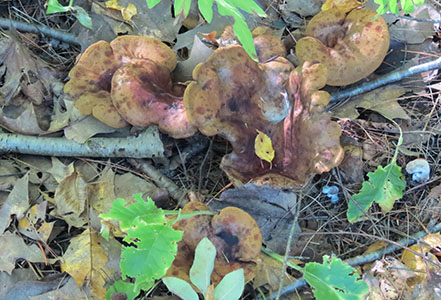

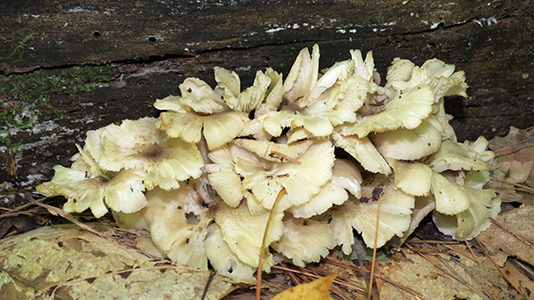
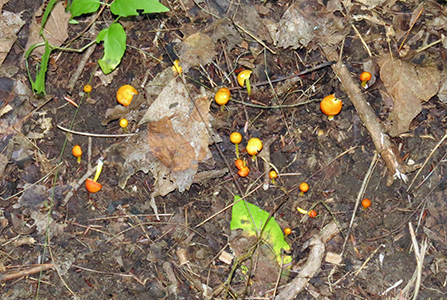
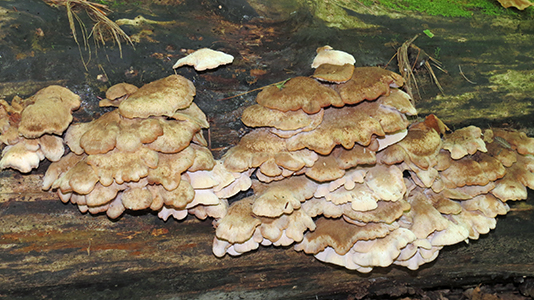
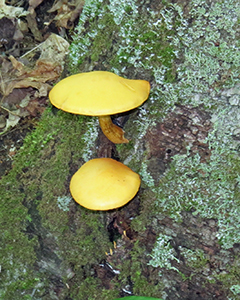
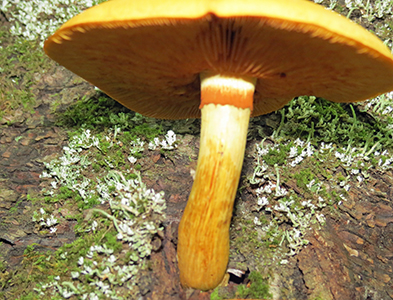
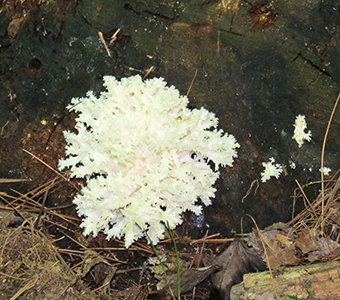
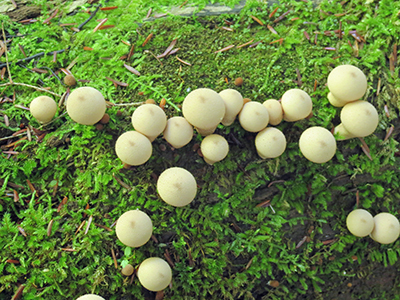
This reaction to loss of substrate has been documented in white birch trees. Inonotus obliquus, commonly called the Clinker Polypore or Birch Conk or Chaga mushroom, lives inside the birch tree in symbiosis, until it realizes that the birch tree has reached old age. At that time it breaks through the bark and forms a conspicuous black conk, which looks like charcoal, which is much prized by Europeans and Asians, who brew it into Chaga tea, a cure for many illnesses, some think. The fertile fruiting body can be found near the clinker; usually appearing after the host tree is dead. Its mission is to find another birch tree to live with in symbiosis.
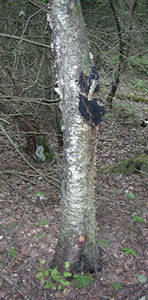

August 2016 PINE IMPERIAL MOTH CATERPILLAR
Photo gallery below – use right arrow to see more
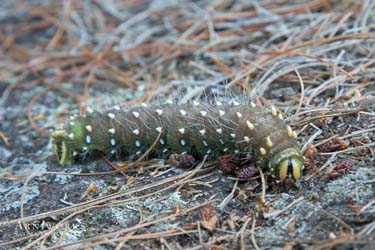
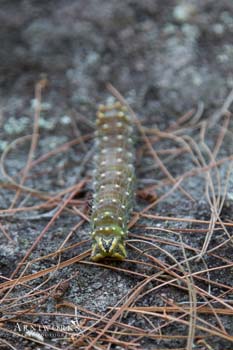
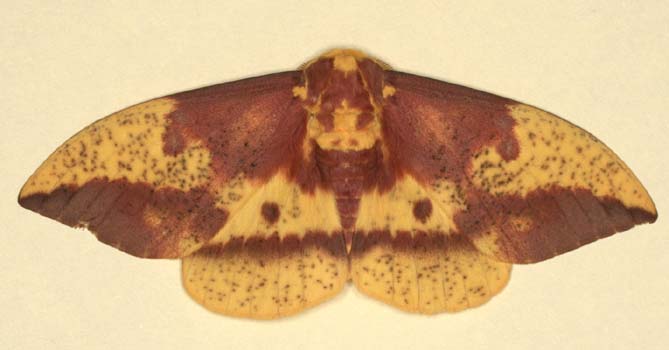
During the club picnic to Victoria Bridge, while we were lunching in a shaded area, Barb Ryckman noticed this juicy sausage sized (about 3 inches long – 80mm) caterpillar crawling up a rock, with great difficulty.
It headed for a leafy area where it would no longer be disturbed, and might pupate. Several members of the club were able to photograph this on the rock. We expected that this was a Giant Silkworm Moth (Saturniidae), since they have robust caterpillars, and some have hairs which do not sting.
However the species awaited identification by Arni, when we arrived home at the books. Pine Imperial Moth ( Eacles imperialis pini) larvae are found in dry pine areas. They feed primarily on pine, but maybe use other conifers. Caterpillars are dark greenish or dark brownish, and have abdominal segments with two paired rows of large shiny white scoli
(fleshy protuberances). The spiracles, or hairs, are white. The larvae are essentially the eating stage, and the adult moths the breeding stage, since the adults do not feed, just mate. Apparently, the moths come to a light between midnight and 2:30 am . The females “ call” from 11-1 am.
The adults fly from June to August, larvae are out from July to September.
There is one generation per year; and the larva overwinters as a pupa in the soil –maybe it was heading for its wintering site when we disturbed it.
It is uncommon and local in Ontario; rare and local in Quebec (in Quebec only 2 sites found where it is common). According to The Natural Heritage Information Centre its status is S3? The ? may mean that “ it is common where found and rare where not found”.
Thanks to Barb for spotting it and to Arni, who lay on the rock to get a face to face view. Al Sinclair of Muskoka provided the photo of adult moth.
July 2016 Emerging Cicada
Sharon and Ron (the photographer) Hancock found this cicada emerging from its larval skin, on July 17, at the Hermitage in Oro-Medonte. It was about 3 feet above ground, clinging to a black cherry tree. This sequence of photos shows the activity from the time they found it until it walked away from the exuvia, about 10-15 minutes. Most of us know the loud Cicada call, in the hot dog days of the summer. But most of us have never seen them emerge.
Our most common cicadas are called Dog-day Cicadas. They may spend several years as nymphs underground, or some may emerge yearly.
The males call to attract the female, who then lays her eggs in tree twigs, which later emerge as robust nymphs which fall to the ground, and burrow down so they can feed on tree roots. After spending their whole immature life sucking on roots underground, a cicada nymph emerges from the ground and clings to an object so the adult insect can climb out of its old skin. The skin splits lengthwise down the back, and the adult insects climbs out as clear winged, brightly coloured adults. The wings are curled at first, but lengthen as the veins fill. The exuvia may persist for some time, and can be recognized by its thick cylindrical body and large forelegs adapted for digging.
Photo gallery below – use right arrow to see more
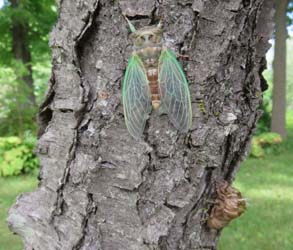
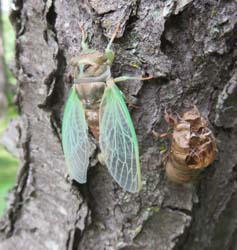
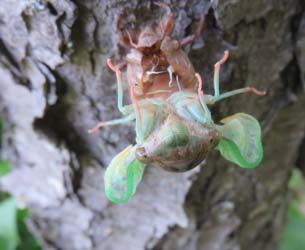
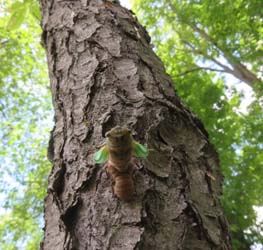
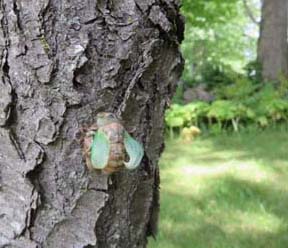
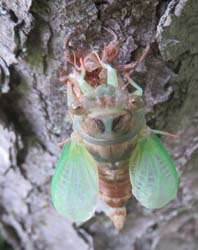
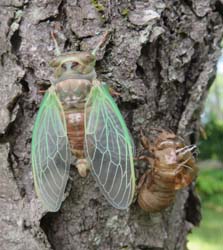
June 2016 Nesting Gulls on Limestone Islands in North Lake Huron and Georgian Bay
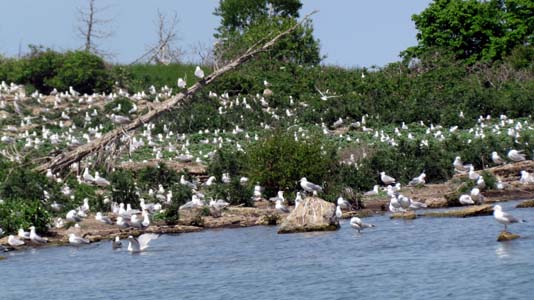
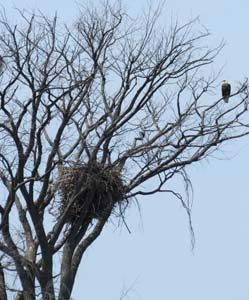
The Ontario Nature AGM was at Evergreen Resort on Red Bay, in Lake Huron, near Oliphant, with 9 from the ONC attending. 5 of us visited the nearby Fishing Islands, in a pontoon boat, where there were nesting colonial birds. We were there on June 4, and saw a few gull chicks, but mainly breeding adults, in both Herring and Ring-billed Gull colonies.
The young will begin flying with the parents in late June or early July, when we will begin to see them, away from the nesting colonies. Some juveniles will probably be in Couchiching Park in July. (Other birds, especially herons, were nesting on these islands too, apparently indifferent to each other. However, we were told that when the Eagle flies there is mayhem among the gulls.) The gull photos are from Barb Ryckman, and the photo of the Bald Eagle, near its nest, is from Heather Ewing.
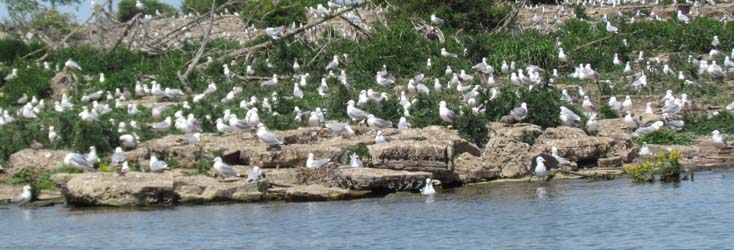
The Herring and Ring-billed Gulls are very common breeding birds, and most likely to interact with humans, not always positively. We take their beauty for granted. Think of the iconic white gull against a blue sky. The sight of a few gulls flying along a shoreline to their roosting sites at sundown, is one of the most relaxing signs that day is done. Don’t think of them at garbage dumps and at fast food outlets.
80 to 94 percent of the world’s breeding population of Ring-billed Gulls and as much as 60 percent of the North American population of breeding Herring Gulls nest in the Great Lakes, mostly on islands. During nesting season they are concentrated at colony sites, making them highly vulnerable.
Surveys by the Canadian Wildlife Service in 1999-2000 recorded over 300,000 pairs of Ring-billed Gulls from the area as a whole. A similar survey of Herring Gulls reported that the Canadian Great Lakes population totaled approximately 36,000 pairs at 974 sites (2003). (This data is from the 2001-2005 Atlas of the Breeding Birds of Ontario.) That is a lot of gulls.
The above photos are from the Fishing Islands, which get their name from the fishery that was supported in the early 1800s. The schools of herring, whitefish, and lake trout were so thick, that it is reported they lifted each other out of the water. However, by 1850, the vast schools of fish had been all but decimated. Should we worry? “Because of the dismal state of the great lakes –colony nesting birds can be susceptible to massive die-offs. So far so good. “ (James P. Ludwig)
May 2016 Home Invasion , 262 Bay St., Orillia
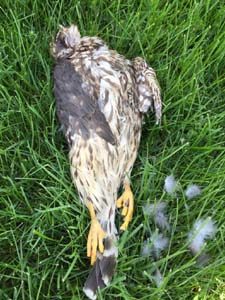 Unfortunately, the Merlins of Bay Street have not done so well. They were observed and their loud screams heard many times, during the first few weeks of May. We think they arrived the first week of April, and copulated frequently (every 20 minutes it seemed) and noisily, until about April 24-27, when we think she started to brood her eggs. On several occasions, after a soft chatter, the female was observed leaving the nest and meeting with the mate, and presumably there was food exchanged. Feathers, from small birds, were seen under a favourite Merlin perch, often yellow feathers (goldfinch). On the very cold May 15, 2 friends came to see the nest. Suddenly there was a loud call, and a Herring Gull was being chased. We watched as it flew to the water, with the Merlin, chasing it – small but brave. Previously it had been seen defending the nest from large hawks.
Unfortunately, the Merlins of Bay Street have not done so well. They were observed and their loud screams heard many times, during the first few weeks of May. We think they arrived the first week of April, and copulated frequently (every 20 minutes it seemed) and noisily, until about April 24-27, when we think she started to brood her eggs. On several occasions, after a soft chatter, the female was observed leaving the nest and meeting with the mate, and presumably there was food exchanged. Feathers, from small birds, were seen under a favourite Merlin perch, often yellow feathers (goldfinch). On the very cold May 15, 2 friends came to see the nest. Suddenly there was a loud call, and a Herring Gull was being chased. We watched as it flew to the water, with the Merlin, chasing it – small but brave. Previously it had been seen defending the nest from large hawks.
On May 19 the Merlin was found dead, with the head off, on a lawn about 700 feet away from nest. It was found and photographed by Kevin Gangloff, and identified by Bernadette Verheil, who had seen it with me on May 15.
On May 20, I heard crows mobbing near the nest. As I arrived to see the cause, a dark bird, flying and flapping slowly, was being chased away by a crow. Probable the female Merlin was being forced from her nest, unable to defend herself alone from so many crows. The mobbing and cawing stopped when the crow successfully chased the bird away. The female has left the area.
It is said the Incubation Period is 28–32 days and the Nestling Period is 29 days. I believe our bird had been on the eggs for about 25 days. The crows knew exactly where the nest was, since they had built it and used it the year before. I believe they waited to attack, when the eggs were large and nearly ready to hatch, so there could have more food.
While a single bird could not predate the nest, a mob of crows succeeded.
April 2016
The Merlins
262 Bay St., Orillia, On
Photo gallery below – use right arrow to see more
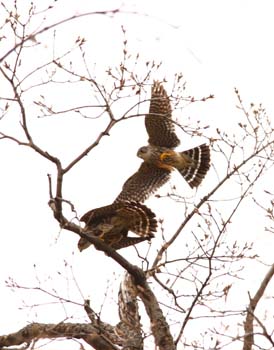
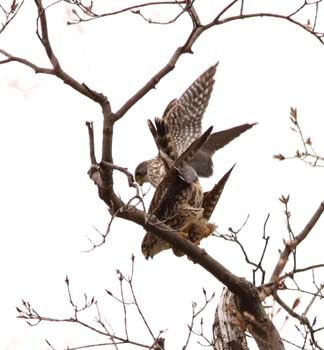

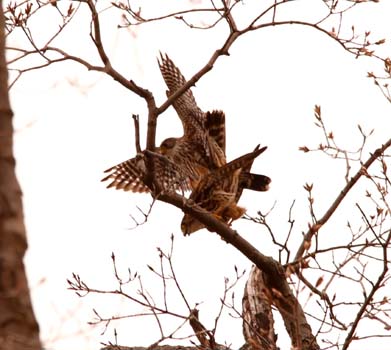
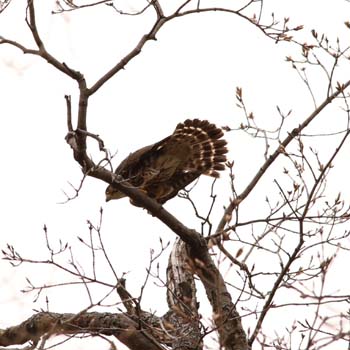
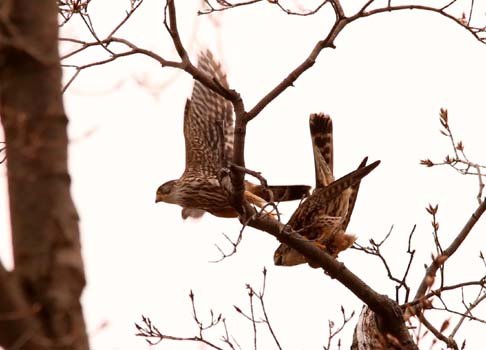
Howard Black took these photos of the Merlins, mating, on a branch of a deciduous tree, about100 feet above the ground, on April 24.
Yard birds on the Orillia Xmas Bird Count are usually Sharp-shinned Hawks or the larger Cooper’s Hawks, which are confusingly similiar. They are both Accipiters, which have comparatively long tails and short rounded wings.
A very vocal hawk arrived on Bay St, the week of April 10. The loud shrill call could not be ignored, and was reminiscent of calls I had heard yearly on a specific site in Manitoulin (Misery Bay area), and of a bird that used to be seen regularly at the corner of Wylie Road and Alvar Road. But this Merlin was in Orillia.
It is in a totally different family than the Xmas Bird Count Hawks- a Falcon, distinguished by their long wings bent back at the wrist. It perched and called, sitting very high on the bare branches. It seemed to call and mate about every 20 minutes. Identification details were hard to see, even with powerful binoculars. Fortunately, Howard Black was able to photograph them (copulating), so we have these wonderful photos. In a tall pine there is an abandoned crow’s nest (we think). We have observed one of them visiting this nest on several occasions.
The Merlin was considered rare from the 50`s to the late 80`s, certainly partly due to DDT. In The Birds of Simcoe County (a centennial project coordinated by O. E. Devitt in 1967) The Pigeon Hawk (Merlin) was considered a rather rare spring and fall transient, usually in April or early May. The Atlas of the Breeding Birds of Ontario (2001-2005) tells of the remarkable recovery and range expansion of this bird, especially since the first Atlas, done in 1981-1985. Then it was almost absent as a breeder south of the 45th parallel.
Now this circumboreal bird has increased its breeding range, especially in the Southern Shield and Lake Simcoe-Rideau area, where the probability of observation increased by 3-4 times in the second atlas. Generally the probability of observation increased by more than 100%. (Meanwhile, another Falcon, the American Kestrel has decreased).
On April 26, 1999, Wendy Hutchings and Muriel Sinclair visited Luke Irwin’s backyard, at Bass Lake Woodlands, and observed 2 Merlins.
On May 5th they recorded a Merlin in a nest at the top of a pine tree.
Ron Reid tells me that there has been a pair in Washago for quite a while, nesting in the pines south of Hwy 169. They also used to nest at the Mackenzie Inn in Kirkfield in the big spruces, but haven’t been there for maybe a decade. Why is this species doing so well, and expanding its range south in a world of global warming?
March 2016 Ecosystems in this mid March spring in a Cedar swamp
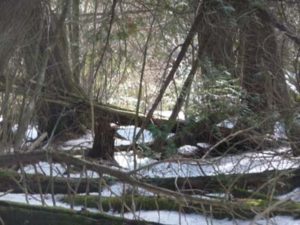
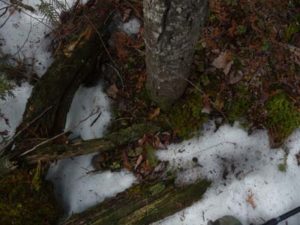
This white cedar swamp has a tangle of fallen logs in various stages of decay.
The unusually warm late February and early March have revealed hummocks of thriving botanical life, at the Langman Sanctuary (managed by the Orillia Hunters and Anglers Club), on Bass Lake Side Road, near Bass Lake Park. These hummocks and old stumps, covered with rich life, rise above the snow. This year we are able to see what has been going on under the snow, hidden from us in March of other years. Bryophytes and lichens can persist and even grow under the snow, since they are able to receive sunlight though the snow. They do well in low light, low temperatures, and moist conditions. Typically they become dormant in summer heat and drought. Bryophytes is the name for the non flowering plants – mosses, liverworts (and hornworts). There are 55 species of mosses documented from Langman Sanctuary, including 11 species of sphagnum,
and 19 species of liverworts. These studies have been done by Frank Cook, late of Barrie, and Linda Ley and Jennifer Doubt from the Museum of Natural History in Ottawa. All photos were taken March 13/16
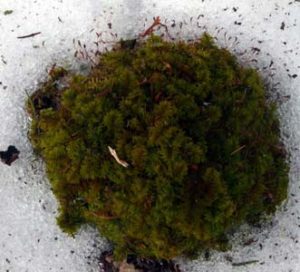
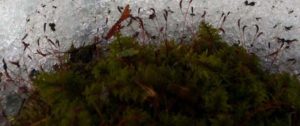
Thuidium delicatulum ( delicate fern moss) ready to send out its spores.
The sporophytes look like a seed pod on a stick (seta), sticking out above the leaves. Some of these sporophytes retain their operculum or lid, some are open, with spores ready to be spread, and some are empty.
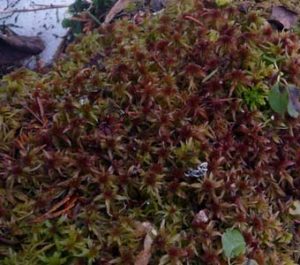
Mosses such as Sphagnum retain considerable water, and experience
little temperature change. They provide safe sites for small animals and invertebrates.
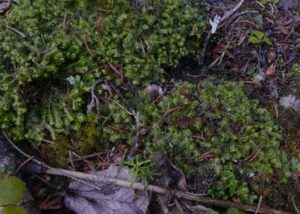
Liverworts are bryophytes, as are mosses. They have 2 very different types, the leafy ones and the thallose ones. This is a thallose liverwort, with 2 rows of leaves on one plane, so that they seem flat. A hand lens shows that there is no sign of a vein, or “ nerve” (as in mosses).
At this time there is no capsule, or fruiting body, which would open by splitting into a four-pointed star.
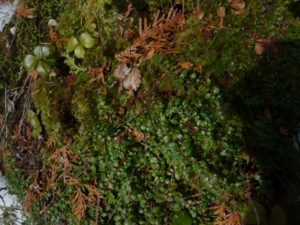
Small cranberry is a low trailing shrub, with shiny oval leaves, whose edges are curved inward, and whose under surface has a white fuzz, similar to Labrador Tea. This fuzz is considered to give them some protection from the cold. Signs of early budding are visible with a hand lens.
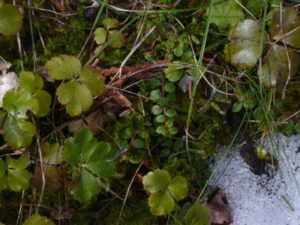
Goldthread is common on the hummocks, and visible because its 3 lobed leaves are evergreen. However there is no sign that it has grown under the snow, and will probably not bud until later.
Spring in mid March
FEBRUARY 2016
Cyanolichens of the Carden Alvar Natural Area by Troy McMullin PhD
Troy did an inventory of the lichens and allied fungi of the Carden Alvar Natural Area (Carden) between April and December 2015. He was impressed by the relatively high abundance and richness of lichens with cyanobacteria (cyanolichens). Cyanolichens are an uncommon and highly sensitive group of dark coloured lichens, many species of which are only known to occur on basic rocks. The exposed and undisturbed areas of calcareous pavement on the Carden alvars provide suitable conditions for these rare habitat specialists.
Lichens are composite organisms comprised of a fungus (the mycobiont) and a photosynthesizing partner (the photobiont). The fungus makes up the majority of the body of the lichen (~95%), and it obtains nutrients directly from the atmosphere and precipitation that washes over it. The photobiont usually occurs in a thin layer just below the surface and makes up ~5% of the lichen – its role in the partnership is to produce mobile carbohydrates. Essentially, these ‘fungi have discovered agriculture’.
The photobiont is usually algae, but rarely it is cyanobacteria (often referred to as blue-green algae), or a combination of both Cyanolichens are particularly sensitive to air pollution, acid rain, and other disturbances. As a result, they do not tend to occur near urban or developed areas and are, therefore, unfamiliar to many people.
In general, cyanolichens make up ~10% of the global lichen biota. In southwestern Ontario, however, that percentage is lower. Two comprehensive lichens surveys have been done near Carden that had a lower percentage of cyanolichens, the Copeland Forest Resources Management Area with 3% (5 species) and Awenda Provincial Park with 4% (8 species). Troy is still working on identifying all of the specimens he collected in Carden so the percentage is currently unknown, but over the last month 12 cyanolichens have been identified.
One cyanolichen genus, Peltigera (dog lichens or pelt lichens), is relatively tolerant to air pollution and disturbance. Peltigera species are the most common cyanolichens in Ontario. In the Copeland Forest, all of the 5 species of cyanolichens discovered are Peltigeras, and at Awenda Provincial Park, 5 of the 8 cyanolichens are Peltigeras. In Carden, 6 of the 12 species are Peltigeras.
Photo gallery below – use right arrow to see more
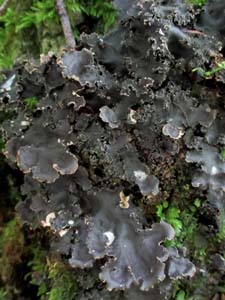
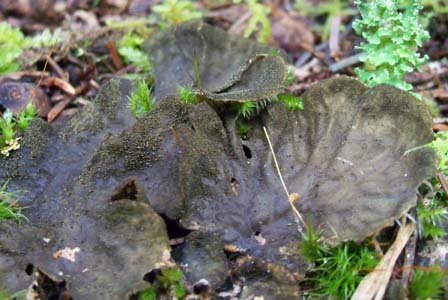
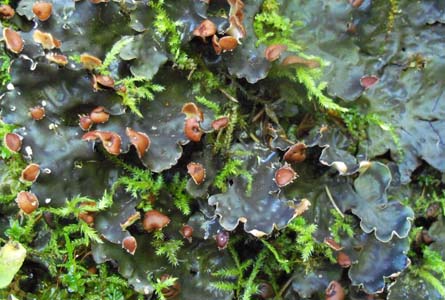
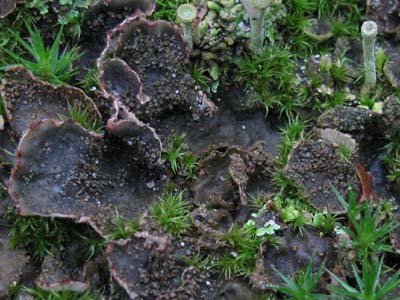
The other 6 species known from Carden are from 5 additional genera, 4 species of which (Lathagrium undulatum, Placynthium nigrum, Scytinium lichenoides, Thyrea confusa) require exposed undisturbed calcareous rock for colonization. As a result, these four species are common on the alvar pavement in Carden. Placynthium nigrum was the only species of the four that was located in either of the two nearby studies. It was growing in Awenda on concrete, an artificial calcareous substrate.
The 12 cyanolichens currently known from Carden are: Lathagrium undulatum (syn. Collema undulatum var. granulosum), Leptogium cyanescens,
Peltigera elisabethea, P. evansiana, P. lepidophora, P. horizontalis, P. praetextata, P. rufescens, Placynthium nigrum, Scytinium lichenoides,
S. tenuissimum, and Thyrea confusa.
Photo gallery below – use right arrow to see more
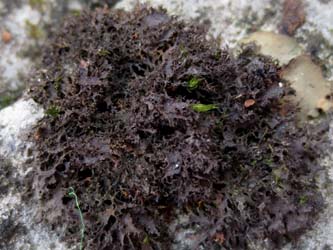
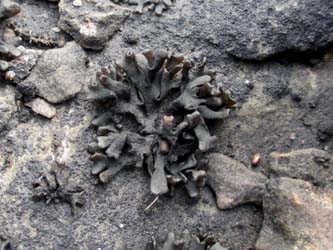
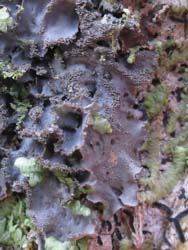
Developing an eye for cyanolichens, particularly the uncommon ones, is a worthwhile endeavour for determining areas of high conservation value
Four of the 6 lichens listed as ‘Endangered’ by the Committee of the Status of Endangered Wildlife in Canada (COSEWIC) are cyanolichens. They are strong indicators of good air quality and undisturbed environments.
If you find rare cyanolichens in high abundance it is a good time to appreciate a healthy environment and clean air, so take a deep breath!
For more about lichens see Finds of the Month: October 2012, February 2012, and December 2011
Thanks to Troy McMullin for supplying the lichen information
January 2016
GULLS AT THE BARRIE WATERFRONT ( KEMPENFELDT BAY)
Open water into January
Brennan Obermayer was one of the observers and photographers, and he provided us with these photos and experiences:
“Over the past few years, I’ve really enjoyed going to Barrie’s Waterfront to go gull watching in late fall until the ice comes in. Watching them feed with such success really can be mesmerizing, especially when they’re in dense feeding areas! This past season was even more spectacular than normal with a large population of Emerald Shiners staying shallow for an unusually extended period of time. This attracted thousands of gulls, which in turn brought several keen birders whom I had the pleasure of meeting and sharing this experience with. On some day’s nine species of Gulls could be observed which includes Thayer’s, Kumlien’s (Iceland), Glaucous, Little, Bonaparte’s, Lesser Black-Backed, Great Black Backed, Herring and Ring-Billed Gulls!”
Peter Mills provided this information about the life cycle of Emerald Shiners, from Mandrak and Crossman’s Freshwater Fishes of Canada.
“Spawning occurs in summer Fish are short-lived (three years maximum)
They are typically a pelagic species, but move inshore in autumn, sometimes aggregating off docks, piers, and river mouths in countless numbers.
These large schools in inshore waters are usually composed of young-of-the-year. As the season advances, they move to deeper water for overwintering. Evidence suggests that emerald shiner populations fluctuate widely in abundance from year to year …periods of scarcity followed by great abundance have been characteristic of the populations for over 50 years This cyclic pattern is attributed to high mortality rates causing drastic changes in age-class structure of populations”.
Photo gallery below – use right arrow to see more
